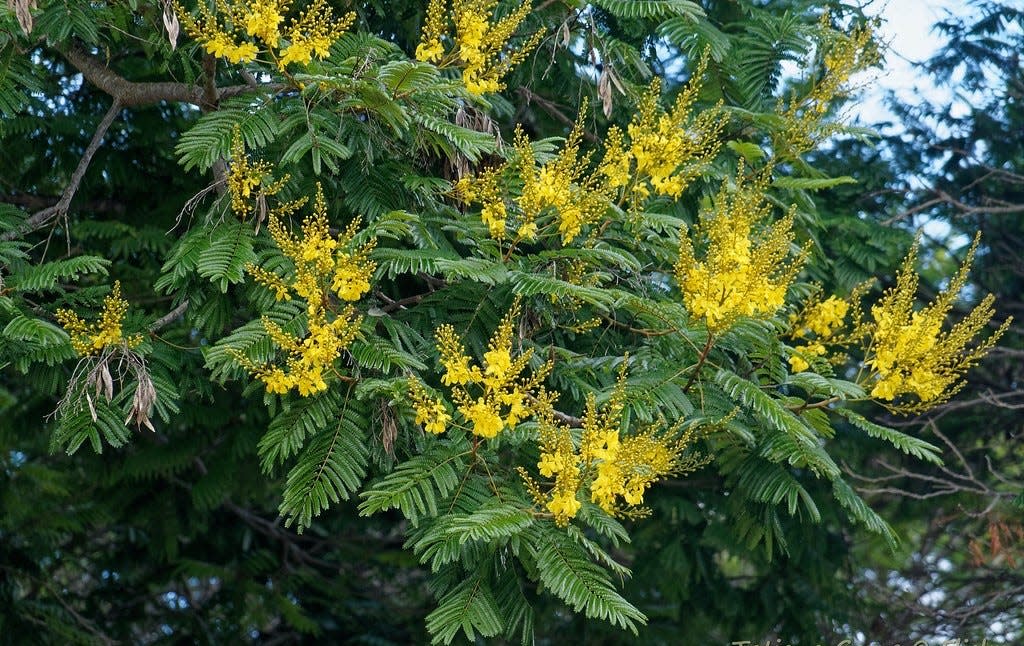Yellow poinciana trees are magnificent shade trees. But boy are their blooms unpredictable

The name "John Chapman" probably doesn’t ring a bell, but his nickname – "Johnny Appleseed" – surely does.
In the 1800s Chapman, a nurseryman and missionary, introduced apple trees into numerous states as well as Southern Ontario. I mention this legendary fellow because he had a small-scale, latter-day counterpart. Clearly, someone who loved yellow poinciana trees (Peltophorum dubium) spread this large, evergreen, flowering tree throughout Central Florida, with the greatest concentration in the Auburndale area.
One of eight Peltophorum species, yellow poinciana – native to Tropical America – averages 30 feet tall at maturity, though exceptional individuals can top 75 feet. A cold-hardy, wind-resistant, drought-tolerant tree that revels in sun, it covers itself with mildly fragrant yellow flowers in spring and summer
Sometimes.
I don’t know of any other plant that’s so capricious about blooming. Although yellow poinciana reputedly blooms in alternate years, that’s not the case. I’ve observed specimens flowering in consecutive years, and then failing to bloom for several years running.
Regardless, this relatively uncommon species is among our most magnificent shade trees, forming a dense and massive canopy of lengthy, lacy leaves. Install trees in full sun on well-drained sites, keeping their eventual size in mind. Propagation is by seed.
Note: Peltophorum dubium is difficult to find in nurseries and online, though related species are commonly offered. Unfortunately, copperpod (P. pterocarpum) is too cold sensitive for Central Florida, though P. africanum, sometimes called African flame tree, is an attractive and sturdy species up to 40 feet tall.
Prepare now for dry weather
‘’It rains all the time in Florida.’’ Gardeners know how silly that oft-heard statement is.
If we’re lucky, our rainy season runs from mid-May to early October. During the other seven-plus months, it’s not uncommon for weeks to roll by without a drop of rain. That’s a particularly dire situation for non-irrigated plants during autumn and spring, when dry, sunny, breezy days are the rule.
So if your landscape does feature an irrigation system, check it thoroughly: Some sprinkler heads may have to be adjusted or replaced. Otherwise, you won’t know there’s a problem until dying turf or shrubs alert you.
Also smart to check soon – and probably replenish – is mulch in both irrigated and non-irrigated areas. Pine bark, pine straw and eucalyptus mulches are best.
Always something going on with candle plant
Many succulents aren’t particularly animated: They more-or-less just sit there.
That’s not so, however, with candle plant (Senecio articulatus), native to South Africa. This three-foot-tall species features sausage-shaped, jointed stems that bear an abundance of pinnate leaves in autumn and winter. The foliage is sometimes accompanied by small, yellow, extremely stinky flowers. In mid-spring the foliage falls, leaving behind an interesting mass of swollen blue-green stems.
Candle plant is suitable for indoor cultivation in sun or shade. Propagate with sections of stem. Plants are available online.
This article originally appeared on The Ledger: Yellow poinciana trees are big and beautiful - and unpredictable

